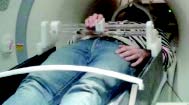By Cristián Modroño et al.
Mirror neurons were originally discovered by the neurophysiologist Giacomo Rizzolatti and his team using electrodes placed in motor regions of macaque monkey brains. These researchers found neurons that discharged not only when the monkeys performed a particular action (e.g., reaching for a piece of food) but also when they observed others (e.g., one experimenter) performing the same or a similar action. This was an important discovery for neuroscience, showing that action perception and action execution are intrinsically linked from the neuronal level.
Besides monkeys, much research has been performed on healthy humans, where for ethical reasons, indirect brain activity measurement techniques are used instead of placing electrodes inside the brain. Functional magnetic resonance imaging (fMRI), a technique which measures brain activity by detecting associated changes in blood flow, is one of the most commonly used techniques. Therefore, it is not common practice to talk about single mirror neurons in humans but rather the human mirror neuron system. Such a system is mainly comprised of motor regions of the brain cortex, and is also activated by both the perception and the execution of a specific action.
A major challenge for researchers is to understand what the mirror neuron system is for. It has been said to play a role in different aspects of the human capabilities, e.g., understanding the actions and intentions of others, imitation, language or empathy; however, its exact functions are still being debated. While basic neuroscience keeps on working to clarify these roles, the essential property of the mirror neurons (i.e., its activation by both executed and perceived actions) also has a clinical application in the field of neurorehabilitation based on action observation. This approach relies on the visual presentation of actions to increase the activity in the mirror neuron system, since this activity may facilitate the reorganization of the motor areas affected by stroke. Specifically, such treatments could be a good option to rehabilitate patients who cannot perform certain movements as a result of an accident.
In line with this research, we have developed an experimental virtual environment based on a paddle and ball game to be used inside an MRI scanner. The participants play the game in one experimental condition where they have to hit an approaching virtual ball back towards their opponent, using a virtual paddle that they control with broad movements of their hand. In the second experimental condition, the participants don’t play: they are mere observers of the games. Their brain activity is scanned during the two conditions using fMRI. The results reveal that not only playing the virtual game but simply observing it produces extended activations in (motor) regions of the mirror neuron system. It is interesting to note that virtual tools can be used to produce mirror activity, as happens when watching videos of ac tors, which is the most frequent option in action observation experiments. In this sense, virtual reality offers several advantages, such as greater control over the presented scene or enabling interaction. The results provide new support for the hypothesis underlying the neurorehabilitation systems based on action observation and encourages further research and development of virtual environments that can be used for patients, even from their own home.
Cristián Modroño, Ph.D. University of La Laguna, Spain cmodrono@ull.edu.es
Gorka Navarrete, Ph.D. Universidad Diego Portales, Chile
Antonio F. Rodríguez-Hernández, M.D. University of La Laguna, Spain
José L. González-Mora, M.D., Ph.D. University of La Laguna, Spain
About Brenda Wiederhold
President of Virtual Reality Medical Institute (VRMI) in Brussels, Belgium.
Executive VP Virtual Reality Medical Center (VRMC), based in San Diego and Los Angeles, California.
CEO of Interactive Media Institute a 501c3 non-profit
Clinical Instructor in Department of Psychiatry at UCSD
Founder of CyberPsychology, CyberTherapy, & Social Networking Conference
Visiting Professor at Catholic University Milan.








